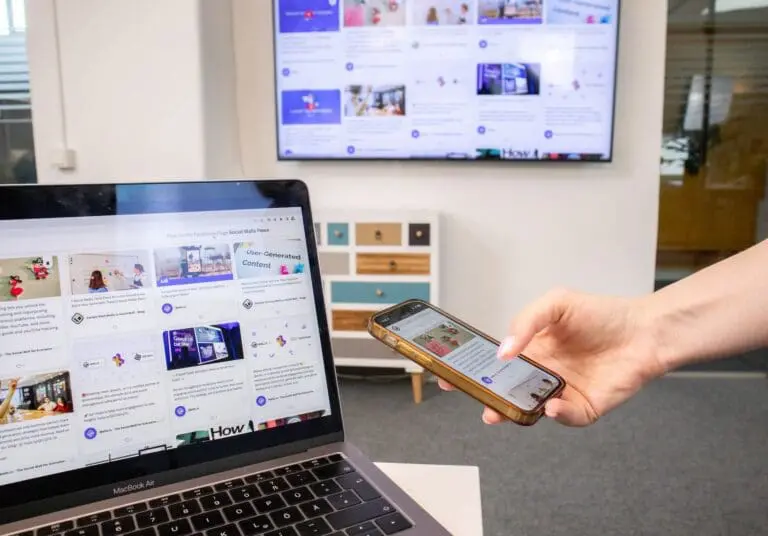Today, we’re zeroing in on a topic that’s close to our hearts: Inclusive Design. Now, you might be wondering, “Why should I care?” or “Isn’t that just a fancy term for something simple?” But hold on a minute, because Inclusive Design is way more than just a buzzword; it’s a necessity.

Imagine this: you walk into a room and realize it’s built for people who are six feet tall, and you’re either too tall or too short. Sounds uncomfortable, right? Well, that’s how some people feel when they navigate websites that aren’t designed inclusively. Web design is not just about pretty colors and cool graphics; it’s also about making everyone feel welcome, regardless of their abilities, age, or background.
So why are we talking about this today? Because we at heyreliable.com are passionate about creating websites that everyone can use and enjoy. We hand-code each site from scratch, ensuring that we don’t cut corners or use quick-fix plugins. We’re a go-to developer partner for agencies and freelancers because we put care and skill into each line of code. And that care extends to making sure the digital spaces we create are accessible to all.
So, if you’re keen to make your website a welcoming space, stick around. We’re going to dive into what Inclusive Design is, why it matters, and how you can implement it. Trust us, this is a read you won’t want to skip.
What is Designing for Inclusion?
Designing for inclusion means creating digital experiences that are usable by as many people as possible. It’s about acknowledging the diversity in human abilities and requirements and designing accordingly. When a website is inclusive, it doesn’t just serve a niche community; it respects everyone’s needs. That means considering text readability for those with vision challenges, ensuring easy navigation for users who rely on screen readers, and providing straightforward interfaces for everyone, regardless of age or tech-savviness.
At heyreliable.com, this isn’t just a principle we admire from afar; it’s a core part of how we operate. When we say we hand-code from scratch, we mean that we meticulously develop every aspect of your website with the user in mind. We don’t opt for one-size-fits-all solutions; we craft unique experiences that are accommodating to all.
You see, designing for inclusion isn’t about adding on extra features or making compromises that dilute your site’s functionality. It’s about seamlessly integrating accessibility into the DNA of your website. And because we don’t use any shortcuts like converter tools or plugins, you can be assured that your website isn’t just meeting the bare minimum for inclusion; it’s setting a new standard for what accessible web design should be.
What is an Example of Inclusivity in Design?
Imagine you’re shopping online for a new pair of shoes. You find a website that not only looks stylish but also feels effortless to navigate. But here’s the kicker: it has a feature where you can easily toggle between various text sizes and background colors to suit your visual needs. The buttons are clearly labeled, not just with crisp text but also with icons that indicate what each button does. Oh, and when you hover over an image, a detailed description pops up, just in case you’re using a screen reader.
That’s inclusivity in design. It’s a website that’s been built not just for the ‘average’ user but for all potential users. And the beautiful part? None of these features feel forced or tacked on. They’re integrated so naturally into the design that you might not even notice them unless you need them.
At heyreliable.com, this is the kind of web experience we aim to create. For every project, we roll up our sleeves and hand-code to ensure that the little details, which make a huge difference, are in place. It’s not about doing extra work; it’s about doing the necessary work to make sure that the website is accessible to everyone.
So next time you stumble upon a website that makes you feel included, chances are, a lot of thought and skill went into that. And if you’re looking for a developer partner to create such a space, well, you know where to find us.
How Do You Create Inclusivity in Design?
First things first, it starts with awareness. Being conscious of the diverse needs of potential users is the initial step. After all, you can’t address an issue you’re not aware of. Whether it’s varying physical abilities, different age groups, or diverse cultural backgrounds, the goal is to factor in the widest range of human diversity imaginable.
Now comes the part where we dig deep into the coding. At heyreliable.com, we take this awareness and translate it into hand-crafted code. We go the extra mile to ensure that things like HTML semantic elements are properly used, not just for SEO but for accessibility. You won’t find any cookie-cutter templates here. Nope, each website we build is coded from scratch, offering the flexibility needed to weave in inclusivity at every step of the way.
It’s also about testing, and then testing some more. Inclusive design isn’t something you just set and forget; it’s an ongoing commitment. We don’t just launch a website and call it a day. We continually test with diverse user groups to ensure that we’re not missing any blind spots. And we do this without the crutch of converter tools or plugins, allowing us to address specific issues more directly.
At the end of the day, creating an inclusive web environment is about marrying creativity with responsibility. It’s not about limiting your site’s potential; it’s about expanding its reach. When you opt for a developer partner like heyreliable.com, you’re choosing a team that understands this balance.
So if you’ve ever wondered how to turn the idea of inclusivity into concrete web design, now you know. It’s a blend of awareness, technical skill, and an ongoing commitment to improvement. And if you’re in the market for that sort of dedication, we’re just a click away.

What is the Principle of Inclusivity Design?
So, we’ve gone over what inclusive design is, shown you a real-life example, and walked you through how to make it happen. Now, let’s get into the underpinning ideals that guide this approach. What are the principles that make inclusivity more than just a checklist?
In simple terms, the principle of inclusivity in design is rooted in empathy and equity. It’s about understanding that your users are diverse individuals with unique needs and challenges. It means approaching design with the aim to cater to as many people as possible, without making anyone feel like an afterthought.
There are generally accepted frameworks, such as the 7 principles of inclusive design, that lay down guidelines on how to achieve this. However, at its core, inclusivity in design is about three main things:
- Flexibility: The design must be usable in multiple ways, catering to a variety of preferences and limitations.
- Simplicity: Information and actions should be straightforward to understand, ensuring they are accessible to users with different skill levels.
- Equity: The design must provide an equitable experience for all, meaning it’s not just accessible but also enables people to participate fully in society.
At heyreliable.com, these principles aren’t just something we read about and forget; they’re woven into our work ethic. When we hand-code your website from scratch, we’re not just filling lines of code; we’re building with these principles in mind. And because we aren’t relying on any quick-fix converter tools or plugins, we have the freedom to really get into the details, ensuring that each website we craft truly embodies these principles.
Perhaps the most important takeaway is that these principles aren’t just ethical or aesthetic guidelines; they’re also sound business practices. A website that’s more accessible and user-friendly is likely to attract a broader audience, which in turn is good for business.
So, in a nutshell, the principle of inclusivity in design is about doing right by your users and, by extension, doing right by your business. If that sounds like the kind of thorough, thoughtful approach you’re after, we’re more than ready to bring your inclusive web design project to life.
Why is Inclusive Design Important?
Alright, by now you’re probably thinking, “Okay, I get that inclusive design is a big deal, but why is it such a priority?” That’s a fantastic question, and it’s one we absolutely need to talk about. Because you see, the importance of inclusive design isn’t just a matter of doing the ‘right thing’; it also has concrete, measurable impact.
First off, let’s tackle the ethical angle. A more accessible and inclusive web experience essentially levels the playing field. It means that everyone, regardless of their physical or cognitive abilities, has the opportunity to access information, shop online, or simply enjoy browsing. Inclusivity in web design is one way to break down digital barriers and foster a more equitable online environment.
But let’s also talk numbers because, at the end of the day, your website also has to serve your business goals. Studies have shown that websites with higher levels of accessibility tend to have lower bounce rates, higher conversion rates, and generally better user engagement. It’s a win-win: you’re doing good while also doing well.
From a legal standpoint, there’s also the matter of compliance with accessibility regulations. Depending on your location and the nature of your website, failing to meet accessibility guidelines could expose you to legal risks. Investing in inclusive design isn’t just a moral decision; it’s a smart business move.
This is why we at heyreliable.com are so invested in creating inclusive web experiences. We understand the stakes. When we hand-code your website from scratch, we’re aiming for a final product that’s both ethically responsible and good for your bottom line. No plugins, no shortcuts, just a full-on commitment to quality and inclusivity.
How Can Design Impact Inclusivity?
Think of your website as a public space. Just like how the architecture and layout of a building can either facilitate or hinder movement for people with disabilities, your web design can either welcome or alienate users. Color choices can impact readability for those with vision impairments. Button placement can affect navigability for individuals using screen readers or adaptive technologies. Even the language used can either be inclusive or exclusive.
At heyreliable.com, we take these considerations to heart when we hand-code websites from scratch. Every design choice is scrutinized to ensure it aligns with the principles of inclusivity. For example, we pay special attention to the contrast ratios to make sure text is easily legible against its background. We also provide alternative text for images so that people using screen readers can understand the content.
But the impact goes beyond the individual user. When a website is designed inclusively, it sends a strong message about your brand’s values. It shows that you care about each visitor’s experience and that you’re committed to accessibility. This can significantly improve user trust and loyalty, which in the long run, are invaluable assets for any brand.
Another angle to consider is that inclusive design often results in simpler, more intuitive interfaces. This doesn’t just benefit those with specific accessibility needs; it makes the website better for everyone. Simplicity usually leads to a smoother user experience, which can help with retention and conversion rates.
Inclusive Design vs Accessibility: What’s the Difference?
By now, you’ve got a pretty good grasp on what inclusive design entails and why it’s so vital. But hold on a minute, you might be wondering, “Isn’t this the same as accessibility? Are they interchangeable terms?” Ah, it’s easy to get the two mixed up, but there are some key differences. Let’s break it down.
Accessibility often refers to the technical aspects of making a website usable for as many people as possible. This generally involves complying with specific guidelines, such as the Web Content Accessibility Guidelines (WCAG), to ensure that your website can be navigated and understood by people with a range of disabilities. Accessibility is often reactive, implemented after a design has been created.
On the other hand, inclusive design is more of a philosophy, a proactive approach taken from the very start of a project. It goes beyond checklists and guidelines and focuses on creating an experience that is welcoming and usable for as many people as possible. It considers not just disabilities, but also other factors like age, gender, and cultural background.
Here’s where heyreliable.com comes into play. We don’t just check off boxes; we build websites with inclusivity as a foundational principle. When we hand-code your site from scratch, we’re integrating accessibility features while also considering the broader experience for all kinds of users. This two-pronged approach ensures that your website isn’t just technically sound but also thoughtfully designed to be inclusive.
While different, both concepts are critical and often overlap. An accessible website may meet all the technical requirements but might still miss the mark in providing a truly inclusive user experience. Conversely, an inclusive design that overlooks accessibility guidelines could still result in a website that is difficult for some users to navigate.

What Is Another Word for Inclusive Design and Why Does Terminology Matter?
Language is a powerful tool. The words we choose can shape perceptions, influence attitudes, and even drive action. So, when it comes to something as important as making the web accessible and welcoming to all, it’s natural to wonder, “Is ‘inclusive design’ the only term we should be using? Are there other ways to describe what we’re trying to achieve?”
You might hear terms like “universal design,” “design for all,” or “human-centered design” being thrown around. While these terms are similar, they are not entirely interchangeable with ‘inclusive design.’ Each has its own nuances, focus areas, and historical context.
For instance, “universal design” often implies a one-size-fits-all approach aimed at creating products or environments that are inherently accessible to everyone, without the need for adaptations or specialized versions.
“Human-centered design,” meanwhile, focuses on involving the user in every phase of the design process, often through extensive research and testing. It emphasizes deeply understanding the needs, constraints, and contexts of the end-users.
So why does this matter? Well, using the right terminology can help set expectations and clarify the project’s goals. It can also influence the methodologies you employ and even the types of funding or support you might be eligible for.
At heyreliable.com, we understand the significance of terminology. Our approach is rooted in what we choose to call ‘inclusive design,’ which incorporates elements from these other philosophies. When we hand-code your website, we aren’t just meeting technical criteria. We’re focusing on creating a digital space that is genuinely inviting and usable for as wide a range of people as possible.
Understanding these distinctions is critical when you’re selecting a developer partner, especially if your project has specific goals around inclusivity and accessibility. So, if you’re interested in a web development process that deeply values inclusivity, heyreliable.com would love to chat with you.
Conclusion
From understanding the fundamentals of inclusive design to learning why it’s distinct from accessibility, we hope you’ve found this deep dive enlightening. If there’s one thing we want you to take away, it’s that inclusive design isn’t just a trend or a buzzword. It’s an essential approach that benefits not only individuals with specific needs but also broadens your reach and enhances user experience for everyone.
At heyreliable.com, our mission is clear: to create web experiences that are genuinely inclusive. And how do we do it? By hand-coding every website from scratch, paying attention to the finer details, and integrating principles of both accessibility and inclusivity right from the start. Whether you’re an agency or a freelancer looking for a dependable development partner, we’re genuinely enthusiastic about the possibility of working together to make the web a more inclusive place.
So, if you’re ready to take your web project to a place where inclusivity isn’t just an afterthought but a central pillar, feel free to get in touch. Let’s make the online world a welcoming space for all, one website at a time.
Get started now
Start with a risk-free, no obligation proposal delivered to your inbox in one business day or less.
Get Started- 90-Day Code Guarantee
- 100% White Label - Sign our NDA
- 24/7 M-F Expert Support




